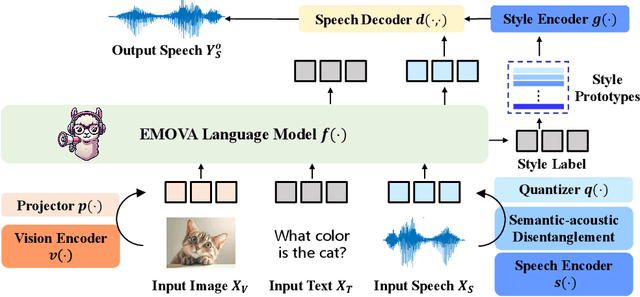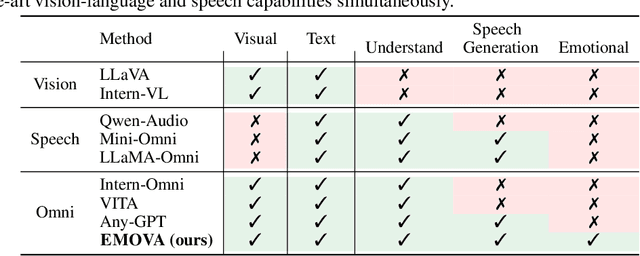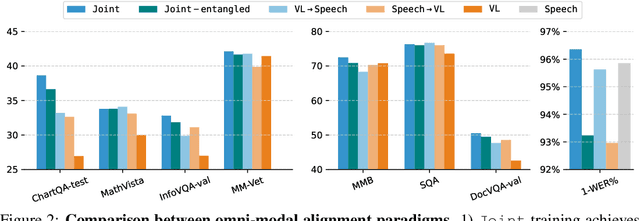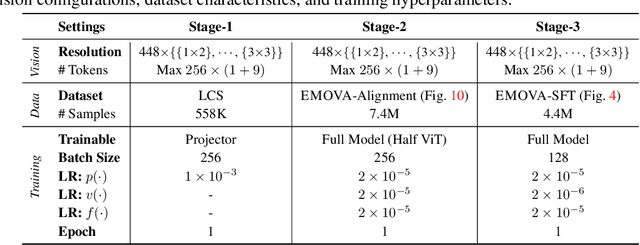Dingdong Wang
InSerter: Speech Instruction Following with Unsupervised Interleaved Pre-training
Mar 04, 2025Abstract:Recent advancements in speech large language models (SpeechLLMs) have attracted considerable attention. Nonetheless, current methods exhibit suboptimal performance in adhering to speech instructions. Notably, the intelligence of models significantly diminishes when processing speech-form input as compared to direct text-form input. Prior work has attempted to mitigate this semantic inconsistency between speech and text representations through techniques such as representation and behavior alignment, which involve the meticulous design of data pairs during the post-training phase. In this paper, we introduce a simple and scalable training method called InSerter, which stands for Interleaved Speech-Text Representation Pre-training. InSerter is designed to pre-train large-scale unsupervised speech-text sequences, where the speech is synthesized from randomly selected segments of an extensive text corpus using text-to-speech conversion. Consequently, the model acquires the ability to generate textual continuations corresponding to the provided speech segments, obviating the need for intensive data design endeavors. To systematically evaluate speech instruction-following capabilities, we introduce SpeechInstructBench, the first comprehensive benchmark specifically designed for speech-oriented instruction-following tasks. Our proposed InSerter achieves SOTA performance in SpeechInstructBench and demonstrates superior or competitive results across diverse speech processing tasks.
A Comparative Study of Discrete Speech Tokens for Semantic-Related Tasks with Large Language Models
Nov 13, 2024Abstract:With the rise of Speech Large Language Models (Speech LLMs), there has been growing interest in discrete speech tokens for their ability to integrate with text-based tokens seamlessly. Compared to most studies that focus on continuous speech features, although discrete-token based LLMs have shown promising results on certain tasks, the performance gap between these two paradigms is rarely explored. In this paper, we present a fair and thorough comparison between discrete and continuous features across a variety of semantic-related tasks using a light-weight LLM (Qwen1.5-0.5B). Our findings reveal that continuous features generally outperform discrete tokens, particularly in tasks requiring fine-grained semantic understanding. Moreover, this study goes beyond surface-level comparison by identifying key factors behind the under-performance of discrete tokens, such as limited token granularity and inefficient information retention. To enhance the performance of discrete tokens, we explore potential aspects based on our analysis. We hope our results can offer new insights into the opportunities for advancing discrete speech tokens in Speech LLMs.
EMOVA: Empowering Language Models to See, Hear and Speak with Vivid Emotions
Sep 26, 2024



Abstract:GPT-4o, an omni-modal model that enables vocal conversations with diverse emotions and tones, marks a milestone for omni-modal foundation models. However, empowering Large Language Models to perceive and generate images, texts, and speeches end-to-end with publicly available data remains challenging in the open-source community. Existing vision-language models rely on external tools for the speech processing, while speech-language models still suffer from limited or even without vision-understanding abilities. To address this gap, we propose EMOVA (EMotionally Omni-present Voice Assistant), to enable Large Language Models with end-to-end speech capabilities while maintaining the leading vision-language performance. With a semantic-acoustic disentangled speech tokenizer, we notice surprisingly that omni-modal alignment can further enhance vision-language and speech abilities compared with the corresponding bi-modal aligned counterparts. Moreover, a lightweight style module is proposed for flexible speech style controls (e.g., emotions and pitches). For the first time, EMOVA achieves state-of-the-art performance on both the vision-language and speech benchmarks, and meanwhile, supporting omni-modal spoken dialogue with vivid emotions.
Exploring SSL Discrete Tokens for Multilingual ASR
Sep 13, 2024



Abstract:With the advancement of Self-supervised Learning (SSL) in speech-related tasks, there has been growing interest in utilizing discrete tokens generated by SSL for automatic speech recognition (ASR), as they offer faster processing techniques. However, previous studies primarily focused on multilingual ASR with Fbank features or English ASR with discrete tokens, leaving a gap in adapting discrete tokens for multilingual ASR scenarios. This study presents a comprehensive comparison of discrete tokens generated by various leading SSL models across multiple language domains. We aim to explore the performance and efficiency of speech discrete tokens across multiple language domains for both monolingual and multilingual ASR scenarios. Experimental results demonstrate that discrete tokens achieve comparable results against systems trained on Fbank features in ASR tasks across seven language domains with an average word error rate (WER) reduction of 0.31% and 1.76% absolute (2.80% and 15.70% relative) on dev and test sets respectively, with particularly WER reduction of 6.82% absolute (41.48% relative) on the Polish test set.
CoLM-DSR: Leveraging Neural Codec Language Modeling for Multi-Modal Dysarthric Speech Reconstruction
Jun 12, 2024



Abstract:Dysarthric speech reconstruction (DSR) aims to transform dysarthric speech into normal speech. It still suffers from low speaker similarity and poor prosody naturalness. In this paper, we propose a multi-modal DSR model by leveraging neural codec language modeling to improve the reconstruction results, especially for the speaker similarity and prosody naturalness. Our proposed model consists of: (i) a multi-modal content encoder to extract robust phoneme embeddings from dysarthric speech with auxiliary visual inputs; (ii) a speaker codec encoder to extract and normalize the speaker-aware codecs from the dysarthric speech, in order to provide original timbre and normal prosody; (iii) a codec language model based speech decoder to reconstruct the speech based on the extracted phoneme embeddings and normalized codecs. Evaluations on the commonly used UASpeech corpus show that our proposed model can achieve significant improvements in terms of speaker similarity and prosody naturalness.
SimpleSpeech: Towards Simple and Efficient Text-to-Speech with Scalar Latent Transformer Diffusion Models
Jun 04, 2024



Abstract:In this study, we propose a simple and efficient Non-Autoregressive (NAR) text-to-speech (TTS) system based on diffusion, named SimpleSpeech. Its simpleness shows in three aspects: (1) It can be trained on the speech-only dataset, without any alignment information; (2) It directly takes plain text as input and generates speech through an NAR way; (3) It tries to model speech in a finite and compact latent space, which alleviates the modeling difficulty of diffusion. More specifically, we propose a novel speech codec model (SQ-Codec) with scalar quantization, SQ-Codec effectively maps the complex speech signal into a finite and compact latent space, named scalar latent space. Benefits from SQ-Codec, we apply a novel transformer diffusion model in the scalar latent space of SQ-Codec. We train SimpleSpeech on 4k hours of a speech-only dataset, it shows natural prosody and voice cloning ability. Compared with previous large-scale TTS models, it presents significant speech quality and generation speed improvement. Demos are released.
 Add to Chrome
Add to Chrome Add to Firefox
Add to Firefox Add to Edge
Add to Edge